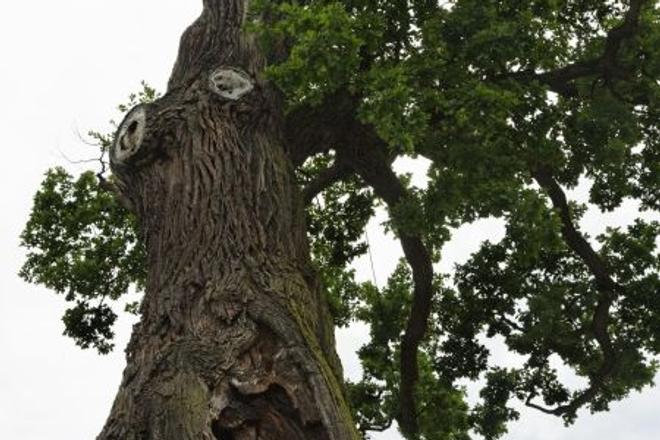Slovakia’s Tree of the Year for 2010 is an English Oak (Quercus robur) from the village of Dubinné in eastern Slovakia which is thought to be 850 years old, making it one of the oldest oaks in Europe. The tree garnered 911 votes out of the 3,907 votes cast in the competition. Viktor Hvišč, the village mayor, told the SITA newswire that the oak was almost destroyed several times as it is near a state road that has had recurring construction. “It is a miracle that it has survived,” he said, as quoted by the TASR newswire, “as some parts of its roots were covered with concrete when the road and the bridge were built. I just cannot understand why it was excluded from the list of trees protected by the state.”
Hvišč said the tree has gradually become the symbol of the village and many stories abound about this very old ‘resident’. During World War I a woman and her child hid in the tree’s hollow trunk which has a circumference of 733 centimetres. The oak’s age cannot be precisely determined as the wood from which the age could be calculated has rotted away. But Milan Hronec, the programme manager of the Ekopolis Foundation which organised the competition, thinks there is no question that it is one of the oldest trees in Slovakia and perhaps the oldest.
A common European Yew (Taxus baccata) from the village of Pruské placed second and the tree is thought to have been planted as early as 1221. The yew is also exceptional because Hugolín Gavlovič, the Slovak Franciscan friar and writer, penned his poems while sitting underneath this yew. The third-place tree was another English Oak, this one from the municipality of Želiezovce and specifically growing in an English-style park planted by the Esterhazy family in the 19th century.
The polling to choose Slovakia’s most outstanding trees ran from July to the end of September from among 12 nominated trees which had been first selected from the original 79 trees entered into the competition. The Ekopolis Foundation organises this annual contest to highlight old, precious and endangered trees and to arouse people’s interest in the environment. The winning oak tree will receive a check-up and expert opinion from a dendrologist from ISA Slovensko, associated with the International Society of Arboriculture, and €333 will be allocated for future care of the tree. The second and third-place trees will receive the same amount.
850-year-old English Oak named Tree of the Year
Slovakia’s Tree of the Year for 2010 is an English Oak (Quercus robur) from the village of Dubinné in eastern Slovakia which is thought to be 850 years old, making it one of the oldest oaks in Europe. The tree garnered 911 votes out of the 3,907 votes cast in the competition. Viktor Hvišč, the village mayor, told the SITA newswire that the oak was almost destroyed several times as it is near a state road that has had recurring construction. “It is a miracle that it has survived,” he said, as quoted by the TASR newswire, “as some parts of its roots were covered with concrete when the road and the bridge were built. I just cannot understand why it was excluded from the list of trees protected by the state.” Hvišč said the tree has gradually become the symbol of the village and many stories abound about this very old ‘resident’. During World War I a woman and her child hid in the tree’s hollow trunk which has a circumference of 733 centimetres. The oak’s age cannot be precisely determined as the wood from which the age could be calculated has rotted away. But Milan Hronec, the programme manager of the Ekopolis Foundation which organised the competition, thinks there is no question that it is one of the oldest trees in Slovakia and perhaps the oldest.A common European Yew (Taxus baccata) from the village of Pruské placed second and the tree is thought to have been planted as early as 1221. The yew is also exceptional because Hugolín Gavlovič, the Slovak Franciscan friar and writer, penned his poems while sitting underneath this yew. The third-place tree was another English Oak, this one from the municipality of Želiezovce and specifically growing in an English-style park planted by the Esterhazy family in the 19th century. The polling to choose Slovakia’s most outstanding trees ran from July to the end of September from among 12 nominated trees which had been first selected from the original 79 trees entered into the competition. The Ekopolis Foundation organises this annual contest to highlight old, precious and endangered trees and to arouse people’s interest in the environment. The winning oak tree will receive a check-up and expert opinion from a dendrologist from ISA Slovensko, associated with the International Society of Arboriculture, and €333 will be allocated for future care of the tree. The second and third-place trees will receive the same amount.


 The winning tree (source: Courtesy of Ekopolis Foundation)
The winning tree (source: Courtesy of Ekopolis Foundation)